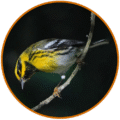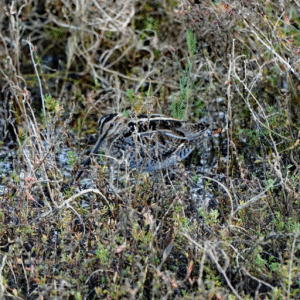
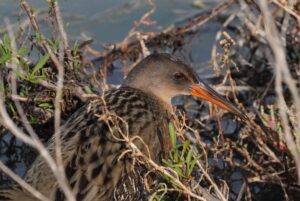
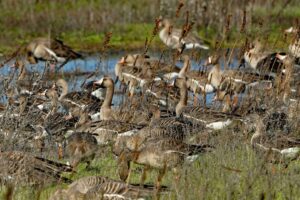
Before dawn on a cold February morning, we climb into the Point Blue survey boat and push off under a starry sky. Petaluma Marsh is quiet but not still. Our puffy jackets rustle in the icy breeze. A slow-rising tide seeps among the pickleweed. Somewhere out in the brackish channels of the marsh, a Ridgway’s Rail calls—a low, grunting kek-kek-kek rising from the reeds. It’s close, but I can’t see it. That’s the point.
We’re perched as quietly as possible in the front of the boat—biologists Julian Wood and Megan Elrod, and myself—taking an auditory survey in the largest remaining natural tidal brackish marsh in California, hoping to glimpse one of the Bay Area’s most elusive birds. Endangered, secretive, and famously hard to spot, Ridgway’s Rails are masters of the disappearing act. About the size of a chicken, with cinnamon underparts and streaked flanks, they melt into the saltmarsh as if made of cordgrass themselves. Their survival depends on it.
Camouflage isn’t just coincidence; it’s an ancient strategy. Across the Bay Area’s grasslands, woodlands, and wetlands, birds have evolved with our local landscape to dissolve out of sight. They rely on concealment to evade predators, raise young, and sometimes even hunt. From the secretive Wilson’s Snipe, whose streaked and mottled plumage mimics the muddy marsh edges where it feeds, to the pale earth-toned Burrowing Owl, which all but vanishes into the dry grasses and gravelly soils of abandoned ground squirrel burrows on the Bay’s urban edges, blending in is often a bird’s first line of defense.
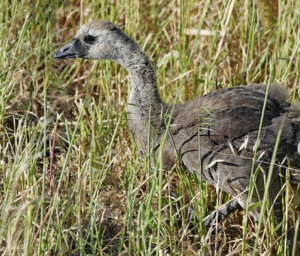
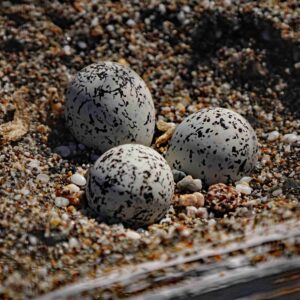
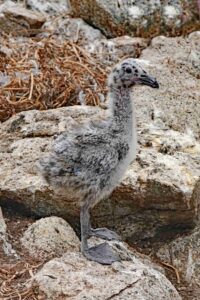
It begins early. Eggs laid on open ground, like those of Killdeer or Snowy Plovers, are speckled to match the sand, gravel, or sticks that surround them. Chicks, too, are born cryptic. Fluffy and downy, they wear the same earth-toned patterns as the terrain beneath their feet. In colonies of Western Gulls like the ones on Alcatraz Island and the Farallon Islands, chicks instinctively crouch low to the ground when threatened, disappearing into the rocks with only their dappled backs showing. For ground-nesting birds like the snipe, this vanishing act can be the difference between fledging and failure.
Adult camouflage often differs between sexes. Female ducks—like the Mallards that glide across Golden Gate Park’s lakes—are famously drab, their speckled brown feathers helping them blend into the shoreline as they incubate eggs. Meanwhile, their male counterparts dazzle with iridescent greens and curls of black and white, with colors that shine brightest during mating season.
Of course, to the delight of local birders, for every bird trying not to be seen, there are as many working hard to be gloriously visible. Take the brilliant American Goldfinch, whose familiar flaming yellow plumage blazes from Bay Area roadsides, or the iridescent Anna’s Hummingbird, whose throat flashes fuchsia when it catches the light in our gardens. These birds aren’t trying to hide—they’re trying to be seen. Visibility can signal health, attract mates, or warn off rivals. In the hummingbird’s case, that gleam of color isn’t always visible from every angle . . . only when the bird turns just right. In that way, even showiness can be selective: a spotlight under the bird’s control.



But not all aspects of color strategy are under a bird’s control—and in a rapidly changing region like the Bay Area, what once offered protection can now carry new risks. Among the dunes of Point Reyes National Seashore, the Western Snowy Plover nests directly on the sand, relying on eggs so perfectly camouflaged they resemble the windswept terrain around them. It’s an incredible feat of adaptation—until an unsuspecting beachgoer or off-leash dog unknowingly tramples a nest. As coastal visitation continues to climb in our region, these fragile nesting grounds are more vulnerable than ever, with camouflage paradoxically becoming a hazard.
Volunteer docents like those led by Point Reyes National Seashore ranger Fiona O’Kelly help spread the word among beach visitors to tread carefully and stay out of fenced areas during plover nesting season. “Conservation efforts across California are focused on protecting snowy plovers, and while scientists are gathering data, volunteers are instrumental in being the boots on the ground,” said O’Kelly. “The team educates the public about how their behavior can sink, or float, this vulnerable species.” Every year, she trains a new cohort of docents, to help visitors be more vigilant while the plovers are busy blending in. (You can become a docent, too!)
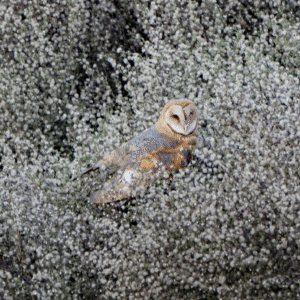
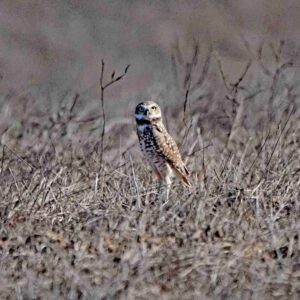
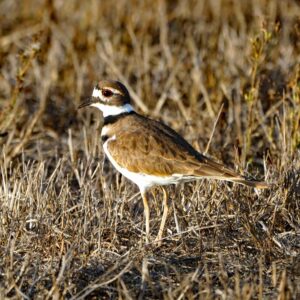
For Ridgway’s Rails, the threats are tied not just to human presence but to the shifting geography of their habitat itself. As sea levels rise, tidal marshes are flooding more frequently, pushing these birds into the higher edges of the wetlands—zones dominated by different plant communities which may not offer the same vertical cover or nesting suitability as the dense cordgrass of the lower marsh. In these altered habitats, the rail’s rich brown plumage can stand out more easily, making it harder to stay hidden from predators and to raise young safely. Camouflage is only as effective as the environment it evolved for. When the landscape shifts too quickly, even nature’s most ingenious disguises can fall short.
For birds like the Ridgway’s Rail, though, staying out of sight still means staying safe—at least for now. Back in the Petaluma Marsh, we hear the call again—closer this time—but I never get a clear look. A flicker of movement, a ripple in the reeds. Then nothing. I lower my binoculars and smile. Not seeing the bird is part of the magic.
In a region known for boldness—bold food, bold tech, bold activism—camouflage is a quieter kind of brilliance. It’s survival through subtlety, a testament to how well life adapts to place, as long as we can conserve the complex habitats with which these animals coevolved.
To watch birds in the Bay Area is to learn to look more carefully—not just for what stands out, but for what vanishes. Sometimes, the best stories are the ones hiding in plain sight.
